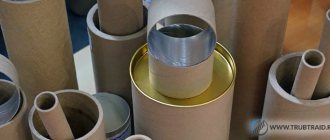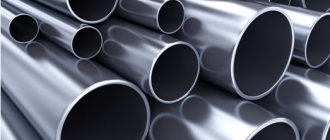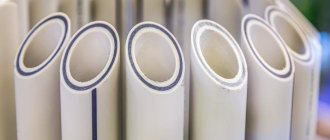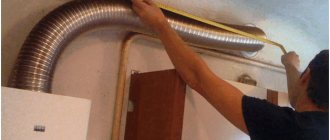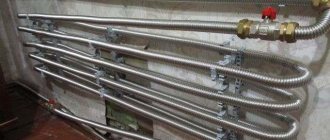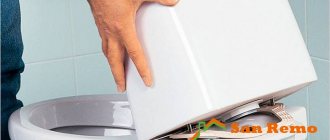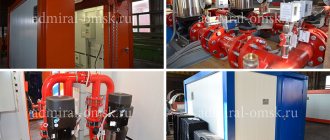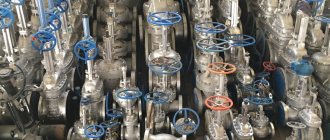Characteristics and differences of corrugated pipes
For reasons of economy and ease of transportation and installation, most modern corrugated pipes are made of plastic. Pipes are divided into:
- single-layer and two-layer;
- equipped with bells and without them;
- straight and curved;
- with and without metal probe.
A pipe whose body consists of two layers is expected to have greater strength than a single-layer pipe, but it is heavier and more expensive. The inner cylinder has smooth walls, painted light gray (for ease of inspection and cleaning from dirt, salt deposits and scale). Only the “outer clothing” of the pipe remains corrugated. Smooth walls guarantee higher flow rates and more efficient circulation in the system. To join pipes, welding and coupling joints are used. Products with a socket on one side are simply inserted into each other.
According to the rules, the bending radius of a curved pipe must be at least three internal diameters. If a two-layer corrugated hose has an internal diameter of 150 mm, then the radius of the rounding must be at least 450 mm.
The metal probe allows you to lay pipes without digging a continuous ditch, using the puncture method. Intermediate holes are dug in the soil along the line of the future pipeline, the pipe with the probe is horizontally immersed in the ground and, using special equipment, is pushed to the next hole. Thus, for example, a drainage pipe is installed at the entrance to the territory of a country house.
Scope of application of corrugated PVC electrical pipe
Corrugated PVC pipe is considered a universal accessory, suitable for protecting cable lines from various external influences, including mechanical damage and contact with various aggressive substances on their surface. The corrugation is capable of ensuring a safe indoor environment, preventing the spread of fire and electric shock to people.
In this article we will look at where exactly corrugated PVC pipes are used.
Main purpose
Corrugated PVC pipes are used for hidden laying of cables. If we are talking about light series pipelines, then they can be passed through special channels in supporting structures, and also mounted on metal frames and other fireproof bases. Heavy corrugated PVC pipe is used in monolithic concrete construction. It can be laid inside a cement screed, as well as a wall or other part of a building made of concrete or reinforced concrete. It is worth noting that a heavy series PVC corrugated pipe can withstand loads of up to 750 N, therefore, when poured with liquid concrete solution, it is not damaged, does not lose its shape and basic properties.
When installed concealed, corrugated PVC pipes can be used in all types of premises, unless otherwise required by industry safety standards. With their help, electrical wiring is most often carried out in panel and monolithic-block houses, as well as in commercial and industrial facilities. In addition, PVC pipes are often used to lay communication networks between floors, provided that they do not pass along the surface of the walls.
External use
Corrugated PVC pipes can also be used for installing electrical communications outside premises without any restrictions. Here they are allowed to be laid along the walls of buildings, in the ground, in concrete, as well as under paths and driveways. In the latter case, it is better to use a heavy series corrugated PVC pipe, since it will provide the most effective protection of the cable from physical stress.
For external installation, large diameters of corrugated PVC pipes are usually chosen. They are attached to solid bases using special clips or brackets, and to prevent sagging, a special cable is used, which is stretched inside the pipeline. In general, it is better to choose a corrugated PVC pipe for electrical wiring with broaching - it will make laying the wire much easier. It is possible to order pipes without drawing - contact our specialists by phone, e-mail or through special services. contact us in the “contacts” section.
However, it is worth remembering that PVC corrugation has rather poor resistance to temperature changes and sunlight. Therefore, when laid openly outside the premises, its service life will be limited to 5–7 years. To avoid this, corrugated PVC pipe should be treated with a special compound with UV stabilization properties, or hidden methods of laying wiring should be used.
As a rule, large diameter corrugated PVC pipe is laid underground. To do this, a trench is created, the depth of which depends on the technical characteristics of the cable passing through the pipeline. In this case, a corrugated polyvinyl chloride pipe is laid on a shock-absorbing sand cushion and then covered with a small layer of a similar material. The trench is filled with soil, which is carefully compacted. If the cable is intended to transmit electricity at high voltage, a signal tape or network is laid in the ground.
Where should PVC pipe not be used?
Corrugated polyvinyl chloride pipes, according to GOST and industry standards, are not used for open installation of electrical wiring in rooms with large numbers of people. The reason is quite simple - such products contain chlorine, which is a dangerous toxic substance. When heated, a corrugated vinyl plastic pipe releases it in the form of a caustic suffocating gas, which contributes to the poisoning of people and the spread of corrosion on metal surfaces.
Therefore, laying PVC corrugated pipes of any diameter (as well as smooth vinyl pipes) indoors is limited. Therefore, instead of PVC pipes for wiring the electrical network in “buildings with large numbers of people”, it is worth purchasing pipes from an alternative material - for example, low-density polyethylene or polypropylene. In the case of HDPE, if open wiring is assumed, you can pay attention to the HFR series with special additives that prevent the spread of combustion (which is the “sin” of pure polyethylene).
Pipe standards and types
- GOST R 54475-2011 – Polymer pipes with a structured wall and fittings for them for external sewage systems.
Prices for corrugated pipes: (price list) by outer diameter OD
Price list dated January 09, 2021.
- D-1000/851mm SN6-7 polymer with socket
RUB 10,161.00Add to cart - D-1000/851mm SN8-9 polymer with socket
RUB 12,174.00Add to cart - D-110/94mm SN8-9 polymer with socket
240.00 ₽Add to cart - D-1200/1030mm SN6-7 polymer with socket
RUB 15,420.60Add to cart - D-1200/1030mm SN8-9 polymer with socket
RUB 17,781.13Add to cart - D-133/110mm SN8-9 polymer with socket
301.00 ₽Add to cart - D-160/136mm SN8-9 polymer with socket
427.50 ₽Add to cart - D-190/160mm SN8-9 polymer with socket
495.90 ₽Add to cart - D-200/171mm SN8-9 polymer with socket
571.00 ₽Add to cart - D-230/200mm SN6-7 polymer with socket
610.00 ₽Add to cart - D-230/200mm SN8-9 polymer with socket
723.00 ₽Add to cart - D-250/216mm SN6-7 polymer with socket
743.00 ₽Add to cart - D-250/216mm SN8-9 polymer with socket
901.00 ₽Add to cart - D-290/250mm SN6-7 polymer with socket
RUB 1,001.00Add to cart - D-290/250mm SN8-9 polymer with socket
RUB 1,219.00Add to cart - D-315/271mm SN6-7 polymer with socket
RUB 1,039.00Add to cart - D-315/271mm SN8-9 polymer with socket
RUB 1,385.00Add to cart - D-340/300mm SN6-7 polymer with socket
RUB 1,317.00Add to cart - D-340/300mm SN8-9 polymer with socket
1,741.00 ₽Add to cart - D-368/315mm SN6-7 polymer with socket
- D-368/315mm SN8-9 polymer with socket
- D-400/343mm SN6-7 polymer with socket
RUB 1,679.00Add to cart - D-400/343mm SN8-9 polymer with socket
RUB 2,157.00Add to cart - D-460/400mm SN6-7 polymer with socket
RUB 2,057.00Add to cart - D-460/400mm SN8-9 polymer with socket
RUB 2,556.00Add to cart - D-500/427mm SN6-7 polymer with socket
RUB 2,715.00Add to cart - D-500/427mm SN8-9 polymer with socket
RUB 3,275.00Add to cart - D-575/500mm SN6-7 polymer with socket
RUB 2,928.00Add to cart - D-575/500mm SN8-9 polymer with socket
RUB 3,645.00Add to cart - D-630/535mm SN6-7 polymer with socket
4,029.00 ₽Add to cart - D-630/535mm SN8-9 polymer with socket
4,802.00 ₽Add to cart - D-695/600mm SN6-7 polymer with socket
RUB 4,409.10Add to cart - D-695/600mm SN8-9 polymer with socket
RUB 5,398.99Add to cart - D-800/687mm SN6-7 polymer with socket
6,332.00 ₽Add to cart - D-800/687mm SN8-9 polymer with socket
7,619.00 ₽Add to cart - D-923/800mm SN6-7 polymer with socket
7,848.00 ₽Add to cart - D-923/800mm SN8-9 polymer with socket
RUB 9,259.99Add to cart
Characteristics and types of polymer corrugated pipes
The most important properties of corrugated pipes, which are indicated in their technical description, are:
- 1. External diameter;
- 2. Inner diameter;
- 3. Ring stiffness coefficient.
The latter is denoted by the English abbreviation SN (stiffness nominal) and is measured in kilonewtons per m2. The most common coefficients are SN4, SN8 and SN16. It is accepted that the coefficient is always a power of 2. Depending on the stiffness rating, all pipes are divided into light (SN2), heavy (SN4 and SN8) and extra heavy (SN16, SN32, etc.).
Lightweight corrugated pipes with a diameter of up to 200 mm are placed in open areas and in hollow building structures. Heavy pipes are laid in ditches in sandy and clayey soils. Extra-heavy pipes with a diameter of 400 mm or more are intended for laying in rocky soils and in areas with movement and winter frost heaving.
It is also recommended to install corrugated hoses of increased rigidity in concrete and stone walls and concrete foundations, which are subject to inevitable shrinkage after the building is put into operation. In addition, increased strength of utilities is needed when installing pipelines for moving hot and caustic liquids, as well as wastewater, in order to avoid contamination of the area.
Installation of corrugated pipes may be required in industrial production to protect communications from negative technogenic influences (high temperatures, thermal compression and expansion, water hammer, vibration).
The final type and size of the corrugated hose is determined based on the mode and purposes of operation, the expected throughput and the characteristics of the medium moved through the pipes.
Suppliers and manufacturers in Russia
- Products Pragma Manufacturer Russia. They are highly resistant to shock loads. Resistant to low temperatures.
- Products Polytron Manufacturer Serbia. It has high ring rigidity. Resistant to chemical influences.
- Products Corex Manufacturer Belarus. Resistant to chemical influences. Used to drain cold and hot water.
- Products Corsis Brand Italy. High ring stiffness. Resistant to temperature changes. Resistant to chemical influences.
- Products Corsis Eco Manufacturer Russia. Made from recycled materials. Applicable in systems without high load. They are distinguished by their low price.
- Magnum products Concern SYSTEM GROUP, Italy. It has high ring rigidity. Resistant to chemical influences. Resistant to temperatures below -40.
- Products FD-plast Manufacturer Russia. They are distinguished by their low price. Resistant to aggressive chemical environments. Resistant to low temperatures. High ring stiffness.
Heavy corrugated pipe
Did you like the video? Subscribe to our channel!
The scope of application of corrugated pipes for laying cable systems is constantly expanding. First of all, this is due to the fact that polymer materials and products made from them are constantly being improved. Builders and installers formulate their requirements, and demand ultimately creates supply. This is how heavy corrugated pipe appeared, which is used today for laying trunk cable networks and installation work at facilities with more severe operating conditions.
Due to its high strength and resistance to aggressive chemicals, heavy corrugated pipe can be laid not only in the ground, but also in concrete solutions. It does not decompose, does not corrode, and its service life is comparable to the service life of residential and industrial buildings. This product has an extended operating temperature range.
Corrugated Heavy HDPE Pipe
For cable laying, corrugated pipe made from low-density polyethylene is widely used. The advantages of this material include low weight, high strength, flexibility, resistance to aggressive substances and moisture. Heavy HDPE corrugated pipe, used for laying main cable networks, is characterized by all these properties. The high degree of reliability and durability of this material allows it to be used at critical facilities, including when laying information lines. Compared to light corrugated HDPE pipes, their heavy counterparts can withstand 2.5–3 times more load with the same outer diameter.
Corrugated Heavy PVC Pipe
For laying telephone lines, computer communications and electrical networks with voltages up to 1000 V, heavy PVC corrugated pipe, characterized by high performance characteristics, can also be used. Its advantages include high moisture resistance and compliance with fire safety requirements. The pipe material does not support combustion, is resistant to aging and has a long service life, which reduces operating costs.
Corrugated heavy PVC pipe provides additional mechanical protection to the cable and its reliable insulation. The material is used for hidden wiring, including in monolithic structures. Its use allows you to replace wiring during repair work without gating the walls. To facilitate installation work, a heavy corrugated pipe with a steel probe is used. It is centered and allows you to easily stretch the wire over a long distance.
Corrugated heavy pipes made of HDPE and PVC combine ease of installation and good flexibility. The material is lightweight, which reduces transportation costs, minimizes unloading time, and makes it possible to avoid heavy equipment when laying highways. A wide range of products allows you to make the optimal choice in accordance with the budget of the work and the tasks to be solved during its implementation.

